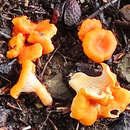fr
noms dans le fil d’Ariane


Cantharellus friesii, the orange or velvet chanterelle, is a fungus native to Asia and Europe.[2] The cap color varies from deep yellow to reddish orange and is 2–4 cm wide. It occurs in beech, fir and spruce forests. C. friesii is considered a good edible mushroom, but because of its rarity, it deserves to be mindfully managed with limited use of fungicides if discovered on residential or commercial property. Harvesting the fruit bodies of the fungus will allow for further propagation of the species as its spores are dispersed along the collector's travels. The specific epithet friesii honors the mycologist Elias Magnus Fries.
Cantharellus friesii, the orange or velvet chanterelle, is a fungus native to Asia and Europe. The cap color varies from deep yellow to reddish orange and is 2–4 cm wide. It occurs in beech, fir and spruce forests. C. friesii is considered a good edible mushroom, but because of its rarity, it deserves to be mindfully managed with limited use of fungicides if discovered on residential or commercial property. Harvesting the fruit bodies of the fungus will allow for further propagation of the species as its spores are dispersed along the collector's travels. The specific epithet friesii honors the mycologist Elias Magnus Fries.